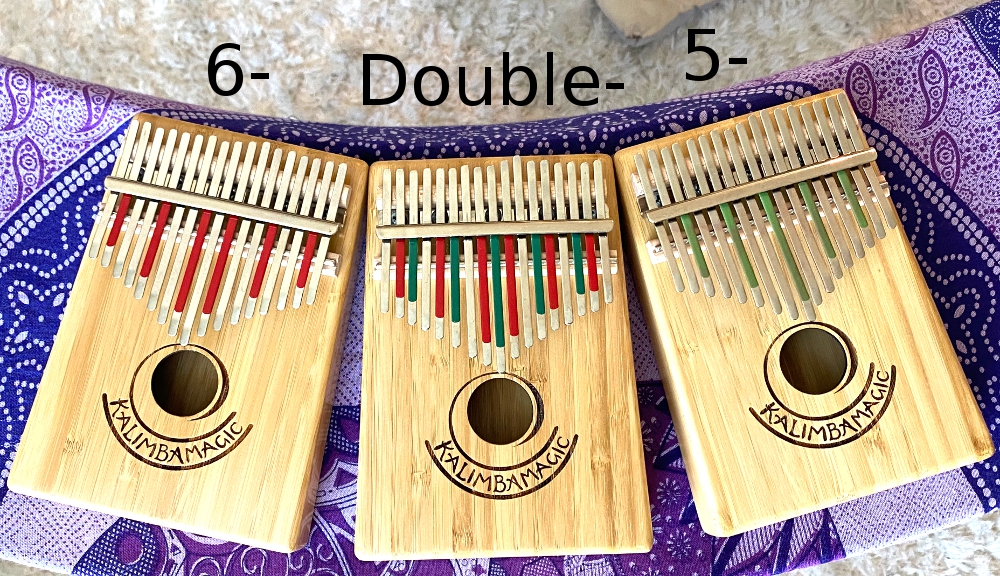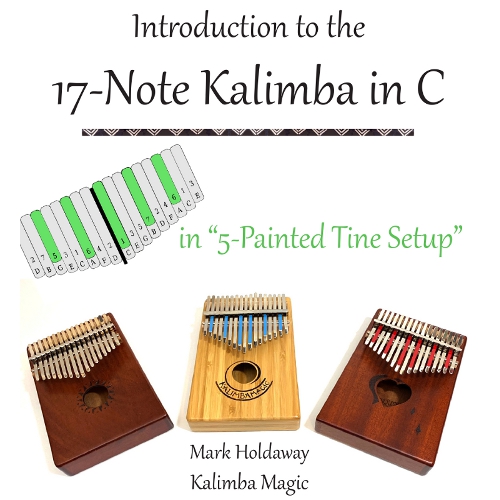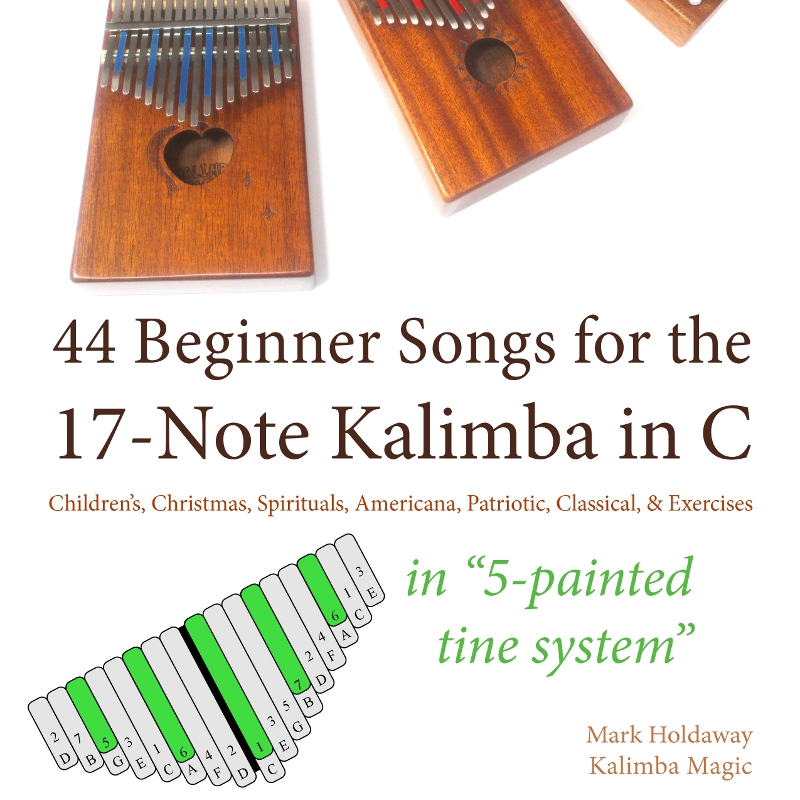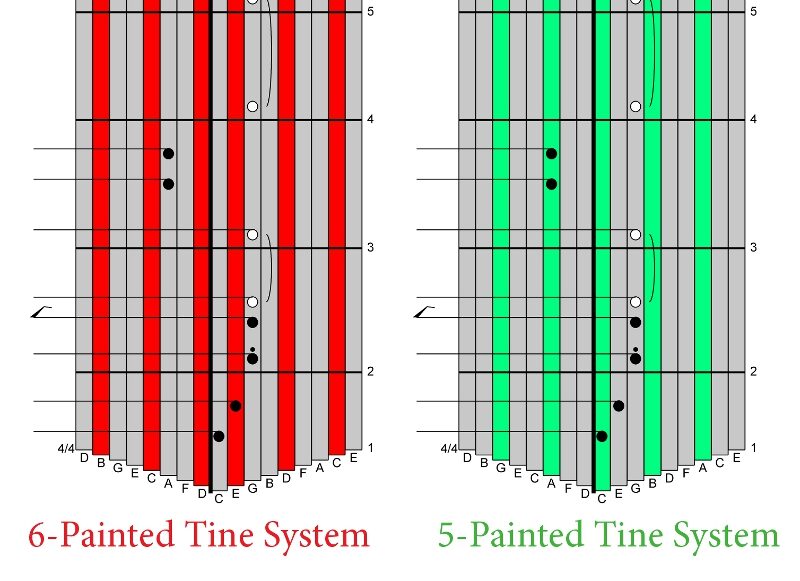Do you have a 17-Note Kalimba in the 5-painted tine system? We have just translated our two most popular ebooks to be compatible with the 5-painted tine kalimba.

In this article, I am not going to tell you WHY there are two competing tine painting systems for the 17-Note Kalimba. I WILL tell you that until last week, all of the books and ebooks I have created for the 17-Note Kalimba in C have been in the “6-painted tine system” – ie, the red tines in the photo. In this article, and in the new ebooks, the “5-painted tine system” is represented by green tines.
 Introduction to the 17-Note Kalimba in C. This 32 page PDF full color ebook has everything you need to get your kalimba journey started. How to read tablature, how to tune, how to maintain your kalimba’s clear sound. Special playing techniques, important kalimba playing strategies, how to play simple melodies. How to add simple and more complex harmonies to the melodies… alternative tunings and other resources available for kalimba players at all levels. It is all here!
Introduction to the 17-Note Kalimba in C. This 32 page PDF full color ebook has everything you need to get your kalimba journey started. How to read tablature, how to tune, how to maintain your kalimba’s clear sound. Special playing techniques, important kalimba playing strategies, how to play simple melodies. How to add simple and more complex harmonies to the melodies… alternative tunings and other resources available for kalimba players at all levels. It is all here!
This version of the book has tablature set up with the 5-painted tine system, congruent with the April Yang videos.
Live links in the PDF drive your web browser to online sound recordings to show you how each of the exercises and songs sounds.
 44 Beginner Songs for the 17-Note Kalimba in C. The 17-Note Kalimba tablature in this book has been recast into the 5-painted tines system favored by the Chinese.
44 Beginner Songs for the 17-Note Kalimba in C. The 17-Note Kalimba tablature in this book has been recast into the 5-painted tines system favored by the Chinese.
These 44 songs have been neatly arranged into a 62 page PDF eBook download with live links to recordings. The songs have been taken from various Kalimba Magic collections and modified for use with the 17-Note Kalimba in the key of C, which is sold under a great many brand names at this time – Donnor, Gecko, Walter, and Heart-17 among others. The collections that went into this download include: African American Spirituals, traditional African karimba tunes, classical pieces, folk and pop music, Americana and patriotic, children’s songs, and exercises.
Several people have asked for these “5-painted tine system” ebooks. If these ones are popular, I will go about transcribing the other 17-Note/C books: “Easy Christmas Carols”, “33 Intermediate Songs”, “Easter Hymns”, “Middle Eastern Music”, “Americana”, and “Duets.”
But as I wrote already: you don’t have to wait for these, if your kalimba is already set up in the 5-painted tine system, you can always put 6 little red marks on the relevant tines, and you are ready to go.
The tine painting helps you play kalimba in these five different ways. One of those ways: the painted tines help you read the tablature. At least, if your kalimba is painted the same way as the tablature portrays its colored tines.
Another viewpoint: if you have three kalimbas, and they are all painted in a certain system, if your fourth kalimba is painted in a different system, you will be confused. That is, if you have established knowledge within some system, there is good reason to stay within that system.
Recently, Kalimba Magic has added the option of the 17-Note Kalimbas in C: you can choose between the 6-painted tine system and the 5-painted tine system. Or, you could have the best of both worlds: get the “double-painted tine system” which uses one color for the 6- and a different color for the 5-painted tines.
If you bought a kalimba from us in our standard “6-painted tine system”, you can learn a kalimba piece on YouTube played on a kalimba in the “5-painted tine system”. Just get out your Sharpie Marker. Choose color that is different from the other 6 tines that are painted. And color in the correct 5 tines.
Or, if you bought a kalimba from China and put decals on the 5-tines they recommend, you can still read Kalimba Magic books. Get out your Sharpie Marker – maybe red, because that is what I tend to use on the 17-Note Kalimba C tablature with the 6-painted tine system.
How to color your tines to help you read tablature in the 6-painted or 5-painted system.
The two bits of tablature below are both for the first line of “Kumbaya”. The notes are exactly the same, and the music will come out exactly the same. The only difference is the painted tines. At Kalimba Magic, we play instruments that look like the one on the left. So, I create books and read tablature within that system. If your instrument is set up with the 5-painted-tines system, you probably prefer reading the tabs on the right.

What is the difference really? It is all about which tines you use as guideposts. A prime example of this is seen when the melody in “Kumbaya” jumps to “A” on the left side in measure 3. The first notes on the right side are easy, because you start on the lowest note and then play the next note to the right, and the next note to the right. They are all connected. But when you jump to the left, you need a guide post. On the green kalimba, you jump to “A”, the painted tine. On the red kalimba, you still jump to “A”, but you note that it is the tine next to the painted tine (which is “C” in this system).


Sign up for our newsletter and free resources with your email address:
We pinky promise not to spam you and to only send good stuff.
 Christmas in July 2025
Christmas in July 2025 Patriotic and American Music for Kalimba
Patriotic and American Music for Kalimba